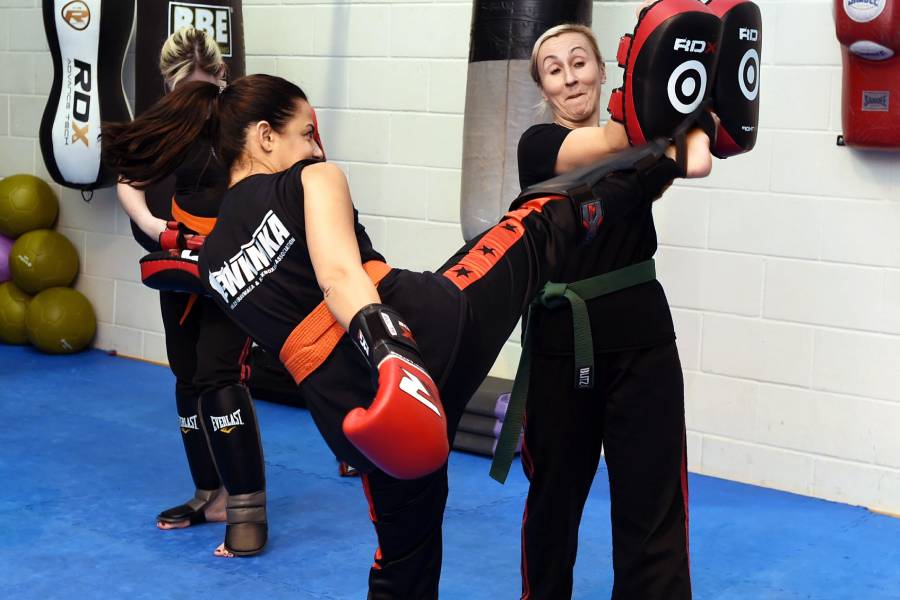Deciding where to start your martial arts journey is challenging. With so many combat sports to choose from, it’s understandable that you might feel conflicted when trying to choose the right one. You might be wondering, which martial art should I learn?
Choosing which martial art you should learn first starts with understanding what you want out of your practice.
Whether you’re trying to fight professionally, use it as a tool for self-improvement, or focus on self-defense, there’s a discipline suitable for you out there.
Training martial arts under the proper guidance will make you stronger, more confident, and more peaceful.
If you enjoy overcoming physical and mental challenges, chances are you will start with one discipline and fall in love with it.
Are Martial Arts A Good Match For you?
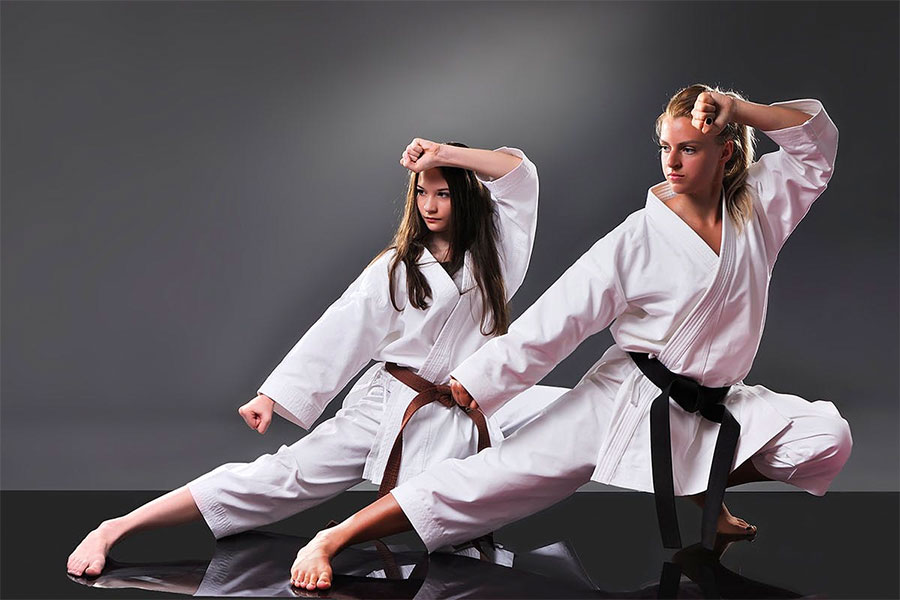
One of the most important aspects of combat sports is to be consistent. If you can’t embrace failure and overcoming physical hardship, martial arts are probably not the right path for you.
I believe almost anyone, with enough dedication, can master the physical skills required for proficiency in several martial arts. But, if your mind isn’t in the right place, you won’t make it past the first months.
The first few days of training will be hard; there’s no way around it. You’ll be sore or tired for days, and that’s something that makes a lot of people hesitant to continue.
However, if you push forward, I guarantee you will change your temperament and the way you approach the hard moments in life.
The extra costs of your combat sports training
You also have to keep in mind that studying martial arts costs money, not only the gym membership. The deeper you go into the rabbit hole, the more you add to it.
For example, uniforms, belts, shin guards, mouthpieces, gloves, supplements, massages, tournament fees, gym equipment, and online courses are common expenses among martial artists.
If you know deep in your heart that this is the path for you, I want to help you. Let’s take a look at some of the most popular martial arts and the best tips to help you pick your martial arts tribe. Let’s go!
Tips To Choose The Right Martial Art
It is essential to understand that there’s not such a thing as the “best martial art.” No discipline is better than others. The best martial art is the one that brings the most benefit to the martial artist based on personal goals.
Also, each style was created for specific needs in different historical periods. The techniques and skills came to life to meet those specific needs. This is why there is no perfect martial art for all objectives and situations.
When you’re trying to find out which martial art should you learn first, there are three things you can do to find your way:
Know Your why
Not all martial arts work for everyone, so sit down and define your why. Ask yourself, and be honest, what do I want out of this experience?
Maybe you want to learn self-defense? Or is competing something you feel passionate about? Or do you plan to exercise more?
The most important thing to know when deciding which martial art should you learn is why you want to start training. You need to think carefully about what motivates you to start practicing.
Do Your Research
Now that you know what your motivation is, research all martial arts to help you accomplish your goals.
Read articles, ask a friend that trains already, watch videos, events, self-defense techniques, and everything you can to get an idea of how it is to practice that discipline.
If you can’t decide on a particular martial art, select two or three to take the next step. Or divide it into categories like grappling or striking-based arts. That’s usually a good place to start.
Take a Free Lesson
Now that you know why you’re doing this and have some research done, it is time to take action. Make some calls and go to a trial lesson.
Most martial arts academies offer free trial lessons so you can feel the gym out before deciding to sign up. If this is your first contact with martial arts, it is highly recommended that you go and try a beginner’s class.
- A few key points to think about after your trial lesson are:
- Did you like the way they trained? Was it good for your physical ability?
- Is the teacher recognized within your local martial arts community?
- Was the teacher humble and overall a nice person? How did you feel with your training partners?
- Is it a respectful and friendly environment, or were they trying to kill each other?
Top Martial Arts In The USA (Based On Data)
You can train many different martial arts, but some stand out as more popular than others. According to a market report by IBIS World, among the top martial arts in the United Estates are:
- MMA
- Karate
- Taekwondo
- Judo
Popular Striking-Based Martial Arts
Striking-based martial arts refers to any fighting style that emphasizes punches or kicks over grappling maneuvers like joint manipulation or throws.
If you’re still asking yourself, which martial art should I learn? Let’s analyze the benefits and downsides of some of the most popular striking martial arts.
Boxing
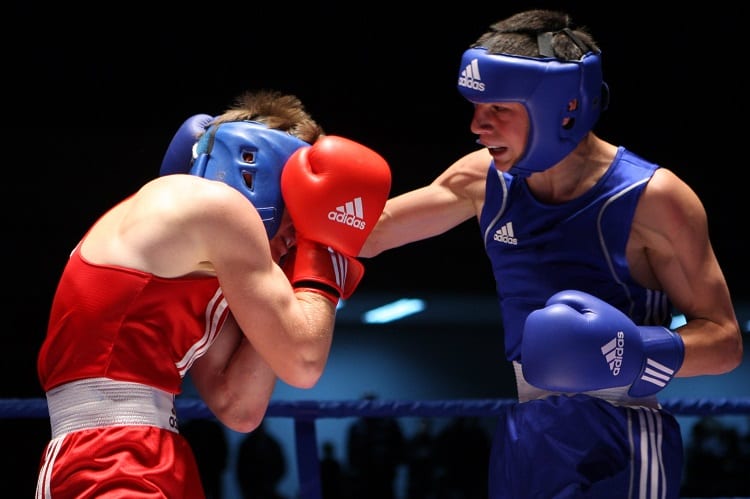
Boxing or the “sweet science” is one of the most popular combat sports of all time. If you like striking-based martial arts, this could be a great place to start. Due to its popularity, you won’t have issues finding a nice gym nearby to start training.
This fighting style is based on the use of your fists, which you’ll use as your weapons to deliver powerful strikes to your opponent’s upper body.
In simple words, boxing is the sweet art of hitting without getting hit. For the untrained eye, it might look like it is all about the fists. However, this is a complex sport where you need solid footwork, head movement, speed, timing, and strength to be a good fighter.
This discipline requires strengthening a large number of muscles. A strong neck helps to absorb the blows better; strong and agile legs are a useful escape from the blows; while the arms, hips, and shoulders carry the power of your punches.
don’t miss the Best BOXING gloves for beginners
What Does Boxing Training Look Like?
A regular boxing session starts with a warm-up for about 5 to 10 minutes. How you warm-up will depend on your trainer, but the common ways to do it include movements like jumping jacks, jump rope, squats, and a few rounds of shadow boxing followed by some dynamic stretching.
Once you’re warm, you’ll work in a specific technical aspect of the sport. Some sessions may be about footwork exercises, sports-specific conditioning like weighted shadow boxing rounds, or working combinations hitting the mitts.
After completing your circuits, it’s common to have a cool-down period that sometimes involves some ab work and then stretching.
How to get Started
A great way to start is with a 1-on-1 session with a private trainer. Depending on where you live, this might not be the cheapest option. But, it might be the best way to clear all your doubts before joining a gym full time.
A private session with a coach as a newbie can help address all your concerns and questions in a safe environment where someone is dedicated only to your progress for an hour.
Another good option is looking for a gym near you and booking a free class. You don’t need to buy gear for a trial lesson; gyms will often have gloves you can borrow. Once you feel comfortable enough and ready to commit, buy hand wraps, a mouth guard, and boxing gloves.
Top Rated Boxing gyms
Some top rated boxing gyms where you could start your search in the US are:
Muay Thai

Muay Thai is a striking-based martial art from Thailand where practitioners learn how to attack using punches, elbows, knees, kicks, and clinching techniques.
That’s why it is often referred to as the “art of eight limbs.” Thai boxing is the national sport of Thailand and is one of the most brutal and effective martial arts in the world.
With the increasing popularity of the UFC, Muay Thai also became one of the most popular martial arts worldwide after proving highly effective inside the Octagon.
Even though Thai boxing is designed for competition, and it has a high risk of injury, it is possible to make adjustments and practice martial arts as a fitness program or for self-defense.
don’t miss the Best Muay thai gloves
What Does a Muay Thai Session Look Like?
The average Muay Thai class starts with a general warm-up after you bow, in respect to your training partners and instructor. It could be running around the mat or some show boxing rounds, followed by some dynamic stretching.
Most classes often focus on pad work and combinations, but it is also common to spend time sharpening your kicks and punches with the heavy bag.
The training normally ends with a cool-down period and some static stretching.
Some schools will also incorporate sparring sessions once or twice per week. Muay Thai sparring can be quite intense at most schools. However, it shouldn’t feel like stepping into the ring, and if that’s the case, you’re probably not at the right place.
How to get started With Thai Boxing
Thai boxing is an intense cardiovascular activity, so don’t feel upset if you can’t keep up the pace at first.
The more you practice, the more your body will adapt to the pace, and you’ll be able to train and fight longer. But, at first, it might be a good idea to train once or twice a week while you adapt depending on your fitness level.
After checking some videos and doing research, look for a gym on Google and read some reviews. Book a free class and give it a try.
If you like the environment, buy a pair of Muay Thai gloves, hand wraps, a mouth guard, and shin guards. That would be good enough to get you started.
Top Rated Muay thai gyms
Here you find some top rated Muay Thai gyms:
Krav Maga

Krav Maga is a complete self-defense system developed by the Israeli army in 1948. Its goal is to help practitioners assess and deal with violent confrontations in a fast and effective manner.
It is used by different military corps in the world, but the civilian version is also widely available. Krav Maga mixes elements from different striking and grappling arts, including gun and knife disarming techniques.
It is common to hear instructors say that Krav Maga is not a sport, and therefore they’re not bound to an established set of rules. That’s why there’s no sparring. It is encouraged to hit areas such as the joints, eyes, or reproductive organs to physically descale the problem as quickly as possible.
learn now how to build Your home gym
Criticism
Krav Maga is a somewhat controversial martial art and is heavily criticized by MMA practitioners due to its lack of realism and sparring.
Some martial artists say that those techniques prepare people to deal with untrained opponents, which means that in a hand-to-hand combat situation with a trained fighter, most Kravist won’t stand a chance.
The techniques are effective to a certain extent, but the lack of widely available legitimate gyms tends to affect the reputation of Krav Maga in the martial arts community.
The bottom line is that Krav Maga is a legit martial art if you train under the right expert. It can help anyone get in better shape, physically and mentally.
What Does Training Look Like?
Training sessions start with students greeting the class yelling, “Kidah!” There’s a short warm-up followed by 20 to 30 minutes of conditioning exercises. Common exercises include push-ups, shadow boxing, technical stand-ups, and jumping jacks.
The technical part of the class tends to focus on drilling a wide range of gun and knife disarming techniques and escapes from common positions like standing neck chokes. Pad work with punches and kicks is also part of your average Krav class.
How to get Started
You’ll find so many dojos claiming they offer Krav Maga, but be careful. Several instructors are not qualified to teach these self-defense techniques. The most important step to getting started is finding yourself a reputable instructor.
KMG Global is the most reputable Krav Maga association in the world. It is not a bad idea to look for your nearest Krav Maga Global Instructor and test some of their classes.
If you like competing and would like to hold your ground against trained MMA killers, Krav Maga might not be the right martial art for you.
But, if you want to get fit, learn invaluable self-defense skills, and have a basic understanding of how to win a street fight, book that free class now.
Reputable Krav Maga Schools
This are some of the best schools available to train legit Krav Maga:
Karate
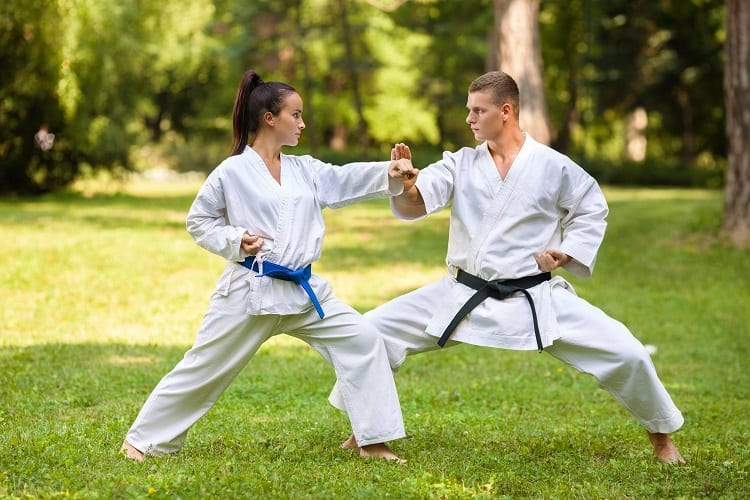
Karate is an oriental discipline that combines Chinese Kung Fu elements with Japanese fighting tradition in a completely new discipline. This martial art is widely popular all over the world and has attracted hundreds of thousands of people.
There are many different styles of karate, but the most popular has to be the combative and widespread Shotokan Karate.
What they all have in common is that punches and kicks are the focus, rather than locks or throwing techniques.
As a full-body workout, karate has a high fitness potential and trains your self-defense and attack-blocking skills, as well as your concentration, body tension, reaction time, and coordination. However, you need to have a little patience when learning.
What Does Karate Training Look Like?
Your average Karate class is structured in three parts: Warm-up, “katas” or combat, and finally stretching.
After the greetings, the class starts running around the dojo for about 15 minutes. Students combine different movements to activate muscle circulation while jogging.
Sometimes in the middle of the run, it’s possible to have some form of dynamic stretching and static exercises like pushups or squats.
After the warm-up is done, the teacher will show a “kata” that will be the focus of the class. These katas will emphasize the movements to help improve the technique over time with repetition.
Then the students get together in pairs to practice attack, defense, and kicking movements to learn how to defend against an attack. This phase can be modified if a student has to take an exam to move up a belt category, which requires a more specific practice.
Finally, at the end of the class, karate practitioners perform various stretches focused on the leg muscles. After the stretching and cool-down period, the students line up by belt, ranking from highest to lowest category, and salute, so the class ends.
How to get Started
You can start by making a list of the top-rated karate schools around you. If the academy offers a demonstration class, try it! Because if you have never trained before, nor seen a martial arts class, you will need to visit several schools before deciding where you want to stay
Make sure to pay attention to how the teacher treats the students. You don’t want to end in a dojo with a difficult environment for learning. Finally, to make things easy, It won’t hurt you to pick the dojo where you feel most comfortable but also is closer to you.
top karate Schools
Here are some of the best karate schools available to train with a legit instructor:
Taekwondo
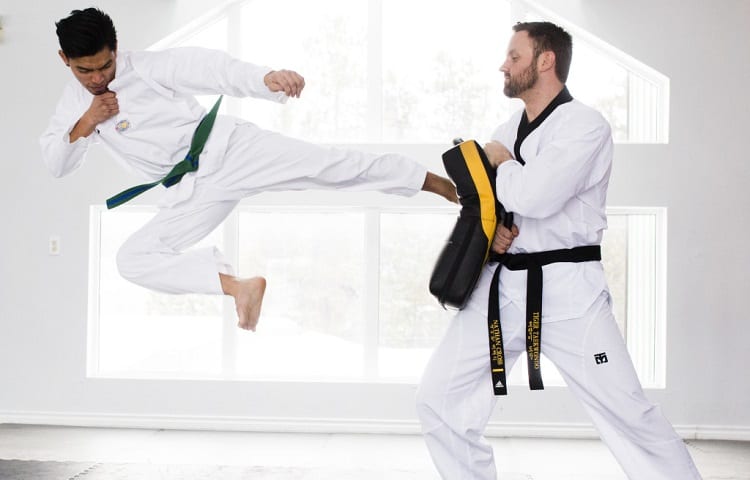
Tae Kwon Do is the Korean equivalent of karate. The name of this martial art translated means “foot technique, hand technique, way” — the way of foot and fist fighting. However, foot techniques are much more prevalent than in any other fighting art.
Taekwondo promotes speed, dynamics, endurance, and discipline. It is a common trait in all fighting arts, but you need some patience and dedication until you can master complicated foot techniques.
The equipment, at a basic level, consists of judo-like clothing. A jacket, pants, and belt. At the competition level, it requires productive gear for the chest, helmet, and gloves.
What Does Taekwondo Training Look Like?
Training might change a little depending on the school. You can find places with light, semi or full contact fights against an opponent, pure self-defense exercises, free practice fights without touching the opponent at all, or practicing the movements without an opponent. Some gymnastics elements are often also included.
How to get Started
Choosing a Taekwondo school can be a tough choice. There are many variables to consider when selecting the right one for you. It is essential that the program chosen meets all of your goals and desires, while also being accessible and affordable.
Choosing a Taekwondo school should be a personal decision that involves both practical and humane elements. It’s important that you dojo offer a mix of expertise and respect for the students.
Be aware that the more advanced your training becomes, the more personalized the instruction should become, so try and find a school with instructors who meet your needs now and in the future.
A quick rule of thumb is to look for a gym that is run by certified professionals. This means that they have received official training and accreditation from an international body or federation. All legitimate schools will carry this paperwork somewhere in their facilities or on their website.
Taekwondo is widely available all over the world. A quick search like, “Taekwondo school near me” will probably show you several options to choose from.
Good Taekwondo Schools
Here are some of the top karate schools available:
Capoeira
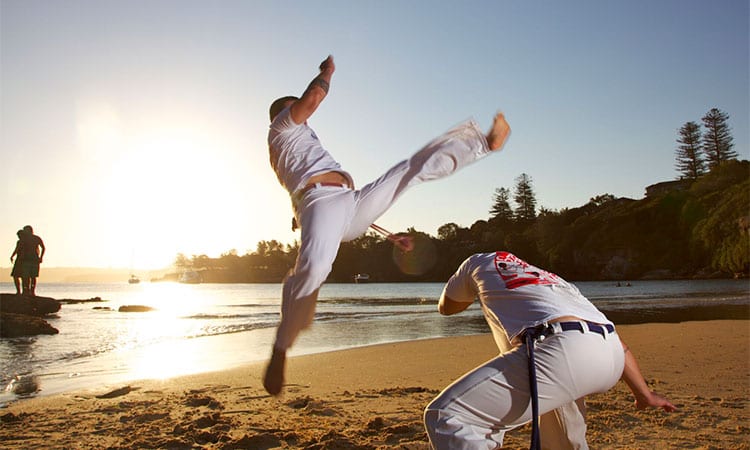
Capoeira was originally developed in Brazil by African slaves who took the offensive and defensive techniques of a martial art called N’Golo – which was performed primarily in a ring – and combined them with dance-like moves.
The result was Capoeira which means “to deceive or to dodge.” Capoeira’s repertoire of movements is often fluid and acrobatic.
Although Capoeira is not as widely practiced as other martial arts, it is still popular among martial artists, dancers, and music lovers. Capoeira is a very difficult martial art to master; it requires a lot of practice, patience, and dedication.
What Does Capoeira Training Look Like?
A Capoeira class for a beginner is on average a two-hour-long session where you’ll be guided through the basics. This includes learning about music, some basic moves, as well as kicks, and punches.
Don’t worry if you don’t know how to do anything, it’s all about keeping things fun and light-hearted. They’ll need to adapt the lesson plan to something suited for beginners.
The Capoeira movements are fluid and energetic. The aim is to flow from one movement to another with grace and agility. You can expect to learn some ballet-like moves as well as kicks, jumps, cartwheels, and lunges.
The lesson will be led by a Mestre (master) who’ll take some time to explain the history of Capoeira, and how it came to be. He’ll teach you about the different instruments used, as well as their roles in the music. You’ll get a rundown about the beats, claps, and chants that will not only help you to enjoy it more but also help you learn new moves.
How to get Started
If you’re interested in trying Capoeira, then you’ll need to find a class near you. The art is taught by Capoeira schools. If you live in a major city, it might be easier to just enroll in your nearest gym and start looking.
Otherwise, type in “capoeira classes” or “capoeira classes near me” online to find out where you can get Capoeira training near you. Don’t forget to test different schools before choosing one.
Reputable Capoeira academies
- Afro Brazilian Cultural Center of New Jersey
- The Brazilian Capoeira Academy
- Capoeira Angola Quintal SF
Popular Grappling-Based Martial Arts
Grappling-based martial arts are where practitioners use joint locks, chokes, and throws to defeat their opponent.
Grappling arts are more focused on fighting on the ground, while standing martial arts like boxing or karate focus more on standing fighting. Mixed martial arts (MMA) also combines both types of combat.
Brazilian Jiu-Jitsu

Brazilian Jiu-Jitsu is a grappling-based martial art that employs joint locks and chokeholds to defeat opponents.
There are many different martial arts, but Brazilian Jiu-Jitsu is one of the most effective means of self-defense and it doesn’t rely 100% on “brute force.” However, if you’re naturally strong and athletic like any other martial art, BJJ will greatly enhance your human potential.
If you want to master Brazilian Jiu-Jitsu, you have to be able to move fast and be flexible. That’s why a lesson in a well-run BJJ school will involve plenty of conditioning.
What Does BJJ Training Look Like?
Classes typically consist of one hour – though it can vary by school. Students will start with warm-up drills followed by learning techniques and live rolling at the end of the class.
In most classes, they’ll usually spend some time on a series of physical conditioning activities, like running, stretching, and some light calisthenics. Stretching exercises will help you become more flexible and limber, which is a very useful attribute in BJJ.
SEcond part of the BJJ class
The second part of the class can be divided between grappling skills – ground fighting – or standing fighting skills – takedowns. The first class in all schools is usually focused on basic grappling techniques which are a must-have for anyone who wishes to learn Jiu-Jitsu.
These techniques include joint locks, escapes and submission holds. But, I recommend you learn all the basic positions first, and then your locks, submissions, and holds will make more sense.
After the grappling portion of the class, you finish off with some light sparring in order to practice the techniques learned during the previous part of the class.
This is the part of the training that gets people addicted to BJJ. Jiu-Jitsu is a unique martial art in comparison to others because it encourages you to challenge the instructor during sparring rather than simply fighting their classmates.
Also, you can go as close as 100% on each round as you want. This allows you to practice your skills in a realistic environment on a daily basis.
How to get Started
An important component of Brazilian Jiu-Jitsu is finding a school that’s the right fit for you. Your BJJ dojo should feel like home. Regardless of your skill level, there are certain factors you should take into consideration.
Lead Instructor, location, and cost may all be difficult to figure out on your own. I’ll share with you some names that can be good schools in your area.
A quick Google search for BJJ schools near your location will do the trick. You can’t also go wrong if the schools you find are affiliates from some of the big three schools:
- Gracie Barra.
- Carlson Gracie Team.
- Alliance.
These were three of the first schools that opened up and are still considered to be amongst the best.
The instructors at these schools have a wealth of experience and knowledge that they have accumulated over the decades. Not only does this make their school a great place to train but it also makes them an interesting person to learn from.
Don’t worry if you don’t have all your BJJ gear yet. No one expects you to have a gi in your first class if you’re new to the game.
Judo
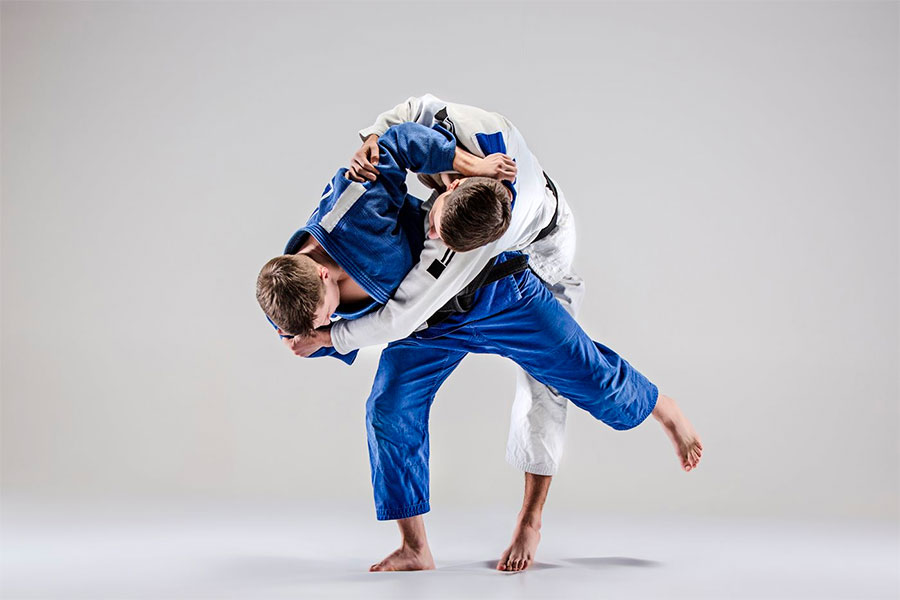
Judo is a form of martial arts that was created in the late 1800s by Jigoro Kano. Originally, it was developed as a grappling martial art with an emphasis on throwing opponents to the ground and utilizing pins.
The name Judo translates to “gentle way,” and the sport of Judo was created to be a recreational activity that people from all walks of life could enjoy. Today, it is practiced around the world.
Judo is fun to practice because it gives you an outlet to expel some of your energy. It also makes you more athletic, focused, and calm under pressure.
What Does JUDO Training Look Like?
Your average Judo class starts with a warm-up. Sometimes this is sports games and sometimes it might be exercises that will loosen up your joints and muscles. Running around the mat, some push-ups, dynamic stretching, and so on.
The next part of the class is learning the techniques in the ground fighting portion of Judo. There are a variety of techniques and in order to learn them, it is common to do the techniques from the ground first.
This part lasts at least 30 minutes, but it’s usually a few minutes longer. That would be about halfway through the class.
When the ground fighting portion of the class it’s done, it’s time to learn the techniques in the standing fighting position of Judo.
The last part of the class will be some sparring. This is where we’ll you’ll put what you learned into practice against partners. In all of these, you get familiarized with how to fall, avoid falls, and throw people properly.
As a beginner, you’ll spend most of your time getting your body adjusted to the core moves a judoka needs to learn.
How to get Started
There are many considerations when looking for Judo schools and it can be hard to find the good ones. First, you have to be sure that the school is a good fit for your needs.
The first consideration is age. You want to find a Judo school that fits your needs and age group. You would also like to find a school that fits your Judo training style.
While price does not always determine quality, you do want to make sure you are paying a fair price for the services that you receive. Finally, you need to find a school with qualified instructors.
All of these things can be found by using the Internet. Once you have decided on the basics of where to train, you can use the Internet to find a Judo school that fits your needs and budget.
The most common way to find a Judo school is by searching the web with Google. Start with the keywords “Judo schools near me” or “Judo schools in my area” and you will get a lot of leads. Visit a few of them and take a free class before deciding to join them long term.
MMA: Both Striking And Grappling Based

Mixed martial arts, also known as MMA, incorporates martial arts from multiple disciplines including Brazilian jiu-jitsu, boxing, and wrestling.
MMA is a full-contact combat sport. But not everybody wants to step into the Octagon and fight someone. Even as a hobby, there are many benefits of training in MMA.
Training MMA will make you mentally stronger, as you’ll constantly overcome hard physical challenges. You’ll learn about self-defense and practical fighting skills. You will also train your body by doing tons of different sports, such as boxing, wrestling, Thai boxing, kickboxing among others.
What Does MMA Training Look Like?
An MMA class is comprised of three or four different segments. The warm-up, drills or technique training, and Sparring.
The warm-up is usually some form of bodyweight exercise, although sometimes it may just be a light jog and some dynamic stretching.
Drills are the most technically demanding and usually involve a combination of many different types of moves depending on which martial art your working on that day.
Sparring is probably the most physically demanding part of an MMA class. It is where you practice the technique you will use in a real fight. Students also learn how to defend themselves from their opponent. It is a hard, fast-paced, and extremely effective way of improving an athlete’s skill.
what are the finishers in MMA?
The “finishers” are exercises that are designed to help increase strength and stamina. They may include various types of push-ups, pull-ups, sit-ups, or weight lifting.
Not all classes include finishers, but if you’re training with amateur or pro fighters it is likely that you have some finishers at the end of the class.
The most important aspect of an MMA class is safety and that you sense an atmosphere of respect between teacher and students.
How to get Started
There are many factors to consider when looking for an MMA school and it can be hard to find the best ones for you. Basic factors to know include the types of classes they offer, their location, and what is their approach to training.
I would recommend spending no more than $150 per month for the first six months. This will give you time to know if this is right for you.
Ask the local people you know who train what they use. If everyone you know trains at the same place you’re leaning toward, you may want to seriously consider that location. When making this decision, remember to make sure the gym has clean locker rooms and showers.
You should also ask about the gym. How large is it? Are there training areas and a ring for sparring? What about the equipment? is everything just free weights? Their style is grappling based or striking based?
Do some research on a few different websites. Findmmagym.com, for instance, is a great place to look into. When you find an MMA gym that seems like it would be good for you, make sure to go down there and check it out.
Sambo

Sambo is a Russian martial art that combines the brutal street fighting of a wrestler with the sophisticated techniques of judo and karate. This makes it an ideal self-defense tool to have in your skillset.
The founder was a Russian man named Grigory Smirnov who taught his style to schools in Leningrad. He had been a student of the founder of judo, Jigoro Kano.
Sambo was designed to be a street-fighting art, which meant there were no rules. This was so that techniques would work in real-life fights where the opponent would simply not obey them.
Sport Sambo, on the other hand, is focused on rules and winning medals. It is competed in as an Olympic sport.
Some benefits of training sambo include:
- Increased strength, endurance, and flexibility – a core component of any martial art).
- Improved balance
- Building a stronger mind-body connection is needed in both sport and self-defense
- Self-confidence to deal with everyday challenges
What Does SAMBO Training Look Like?
An average Sambo class will begin with some basic stretching and warm-up, a review of the basic principles involved in the day’s technique, and finally, some sparring. The last stage is what people enjoy the most, to practice what they’ve learned against a resistant opponent.
In the stretching part of the class, your teacher will usually teach you how certain movements are not good for the back or cause injuries if care is not taken.
The warm-up part of the sambo class is usually very active, consisting of running around, some gymnastic-like movements, and some slow-motion exercises to stretch muscles prone to injury.
The class’s principles section is where your trainer will explain the basic movements involved in your technique. He will teach you about the proper way to stand, move, fall, and grab your opponent.
Finally, in the class’s sparring part, you will get to apply what you’ve learned during the previous hour.
How to get Started
There are many elements to analyze when you’re looking to enroll in a Sambo school, and sometimes finding the right one can be challenging. The ideal Sambo gym has teachers with great knowledge, the right price for your budget, and respectful training partners. That’s the sweet spot.
Finding a Sambo school that meets your needs is as simple as asking around when you’re already a Sambo practitioner in a new city. The more people you have on your side, the more likely you will be to find the right school with your martial arts network.
For beginners, the process is a bit different. You might need to do some research on the web.
Start with more popular Sambo schools. Search for “Sambo schools in the USA” or “Sambo schools near me.” These are the best places to start your search.
You can also call Sambo schools in your country or you can email them. It is helpful to start with a school ranked high in the Internet search results that has good reviews.
Freestyle Wrestling

Freestyle wrestling is a form of wrestling practiced all over the world. It is one of the fastest-growing styles in America. Unlike Greco-roman wrestling, freestyle wrestling does not follow many restrictions on attacks while grappling and there are no positions that must be held a certain way.
There is a mixture of standing, heel hooking, and ground fighting in freestyle wrestling. For example, a wrestler in the final round of a tournament may “tap out” using his hand to signal he has given up rather than being physically held down for three seconds.
FreeStyle is also one of the three styles in the sport of wrestling:
- Folkstyle
- Greco-roman
- Freestyle
It is also a style that has been increasing in popularity over recent years with more young people choosing it as their main sport. In part thanks to the increasing popularity of the UFC and the plethora of champions with a solid wrestling background.
Many people find this style attractive because it allows you to utilize different grappling holds, throws, and spins. Freestyle wrestling is probably the most popular style of wrestling. It’s extremely dynamic and entertaining to watch.
Training tends to be very acrobatic and intense. This is why it might be better to start with this form of wrestling at an early age.
What Does Wrestling Training Look Like?
A freestyle wrestling class will start out with a warm-up and then some stretches. Then, you will do drills that help you learn to move on the ground, go from defense to offense and be able to maintain an offensive position.
Another important aspect of freestyle wrestling is learning how to escape a pin by getting out of the hold or by recovering your position on the mat. In addition, an important skill is being able to defend a takedown.
The conditioning needed for freestyle wrestling includes a strong base, hip flexibility, and good shoulder mobility. The main aim of the conditioning part of the class is to help you develop the muscle groups of a strong wrestler through movement and bodyweight exercises.
In addition, one of the most important things in freestyle wrestling is knowing which techniques to use. In freestyle wrestling, there are many different positions.
Knowing how to transition from one position to another and being able to time doing it correctly is an important part of your training sessions.
How to get Started
After considering if freestyle wrestling is the best option for you. The first step in getting started is to find a gym. In most large cities in America, there are usually several wrestling gyms.
If there aren’t any, then search online for the closest one to your area. After finding a gym, call the gym owner and set up a meeting or free class with them. This is the time to ask as many questions as possible bout the gym.
The schedules and costs of the gym are probably great starting points. Also, ask about the wrestling rules and regulations if your interesting in competing at some point.
Best “Soft” Martial Arts To Start Training
Ask about the experience of other people who train there. Make sure that you are comfortable with what they have to say about the gym before deciding to train there. If everything checks out in your free class, then you can sign up for a month and start training!
Traditional martial arts are usually those that have been around for hundreds or even thousands of years. They typically emphasize tradition and culture.
Traditional martial arts training concentrates on a practitioner’s physical and mental health, while modern combat sports focus on fighting skills to win competitions.
Wing Chun

Wing Chun is a form of Chinese Kung Fu. It comes from some of the most effective hand-to-hand combat techniques that were used in Ancient China.
What is so exciting about Wing Chun though, is that it can be learned for self-defense and also for recreation. However, only since the early 20th century, it has been taught to westerners.
Wing Chun became more popular in the western world thanks to the Bruce Lee movies and recently it gained more notoriety after the Ip Man movie in 2008.
Most schools today teach a mixture of the modern curriculum and what was passed down from the original instructor. But, many schools have been established that teach only the original curriculum. Keeping the art in a pure form.
Wing Chun has been criticized by the MMA community for its lack of a clearly defined sport version. However, many martial artists have embraced some techniques of the Wing Chun curriculum with adjustments to make them suitable for modern combat.
Wing Chun does not include any traditional Chinese attributes such as animal imitations, energetic movement, or traditional weaponry. It is actually a very modern martial art but is not as effective as Boxing, Muay Thai, BJJ, Judo, and Wrestling.
What Does Wing Chun Training Look Like?
A Wing Chun class starts with a warm-up and stretches. This is to keep the body loose and limber. The instructor will then go over the stance and some basic strikes. The class will then break into groups of two.
One student will act as if they are in a fight and the other student will guard by trying to hit them with punches, kicks, and blocks. The instructor will move around correcting their stances and their techniques.
The instructor will sometimes throw out a technique to see how they do against it. The student will have to then make a counterattack.
How to get Started
When you’re ready to start training Wing Chun, the first thing you’ll need to do is find a good gym. You can do that by doing your due diligence online. Wing Chun isn’t as popular as karate is. Most likely, you’ll only find Wing Chun schools in major cities.
If you’re able to find a good school online near you with good reviews and reputation, first and foremost, ask them how long they have been teaching. Anyone can claim to be an instructor, but not everyone has had the experience to teach Wing Chun. How much do they charge, and what’s the schedule.
Ask them how many students they have and if it’s possible for you to book a free class to see what they’re all about. After your free class, you’ll have a good grasp of the school atmosphere, and you can decide whether or not that’s the place for you.
Tai Chi Chuan
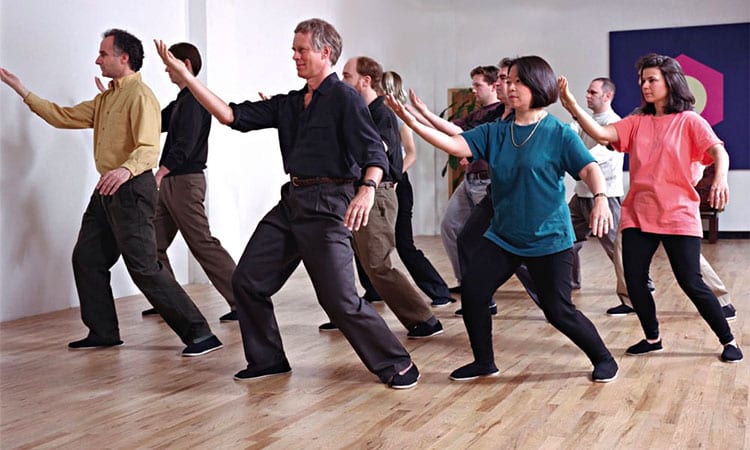
Tai Chi Chuan is a form of martial art that is deeply rooted in ancient Chinese culture. It was created many hundreds of years ago as a way to enhance vitality, health, and increase longevity. Practicing Tai Chi Chuan is one of the best ways to reduce stress, increase energy, and improve overall health.
Tai Chi Chuan is very easy to learn but difficult to execute with mastery. You can start with simple movements and then gradually progress until you perform more challenging sequences. Practicing Tai Chi Chuan can be an enjoyable, stress-free way to keep fit and healthy.
It can also be a great addition to your main martial arts practice. It helps you with conscious breathing, calmness, and coordination.
What Does Tai Chi Chuan Training Look Like?
A Tai Chi Chuan class usually starts with some qigong moves, then you will start doing tai chi forms.
You will start to do the form, and you should try to keep your hands loose because you are not hitting anything. The movements should be slow and smooth. You must be in a very introspective and meditative state when performing those forms.
After you finish the form, your teacher will explain to you what it is all about. and provide feedback to adjust your technique.
If you have trouble with some of the movements, your teacher may direct you to a specific part of your body. He can show you an adjustment movement to get your body aligned properly with the incoming force.
Some of the Tai Chi Chuan forms are so complicated, that it will take you years to master them. But no matter which level are you at, after a class you will feel energized and relaxed.
How to get Started
If you’re ready to join a Tai Chi Chuan class, first you will need to find a studio near you that offers it. While many studios offer Tai Chi, not all of them offer the same level of instruction. Pay attention to reviews online and before you join, try to see if you can watch a class. This will give you a good idea of how the class is taught and if it is a good fit for you.
When you first enter the studio, speak to one of the instructors. The instructor may ask you a few questions about your experience with martial arts and/or Tai Chi. Beforehand call them and ask if they can help you with an introductory class.
Once you decide to take a class, you should have a better idea of what it will cost. Sometimes, studios that ask for pricing up front are reluctant to give refunds or discounts. So make sure you understand what are all the costs involved.
After your first lesson, you’ll probably know if you see yourself in Tai Chi class long term or not.
Aikido

Aikido is a form of Japanese martial arts. It’s a method for defending oneself and inflicting minimal harm on the attacker. The word “Aikido” is a blend of “Ai,” which means harmony, and Ki, which is life energy.
In Aikido you learn to use all of your body for power and control, both empty-handed and with weapons. You learn to take the momentum of the attacker’s blow and put it in a harmless direction.
Aikido has been heavily criticized by the MMA community in the past. Many MMA fighters believe it is a pointless martial art since it’s so easy to defeat an opponent using Aikido.
Aikido is not proven to be an effective martial art to defend yourself in a real-life. Several techniques are almost impossible to apply in real-life scenarios and they never practice against resisting opponents. However, it offers many other benefits to its practitioners.
Aikido is a wonderful martial art for many other reasons. The benefits of Aikido include:
- Having better posture and body control.
- Deeper peace of mind.
- Being able to fall safely without hurting oneself.
- Aikido’s practice is not as brutal as some martial arts and is very gentle on the body.
If you’re looking for a gentle way to sharpen the mind and body, Aikido could be a good option for you. But, if you’re expecting effectiveness in self-defense and combat, Aikido lacks several elements that are now fundamental in modern martial arts.
What Does AIKIDO Training Look Like?
Your average Aikido class starts with a warm-up period. This part usually involves some stretching and a bit of cardio.
After the warm-up, your teacher will break down a set of techniques that you will learn and then implement in the partner exercises known as randori.
Partner exercises are vital for understanding techniques because they allow you to apply the techniques to someone. The class finishes with some down and stretching exercises. Some classes might include meditation or a lecture from the class instructor.
That is the basic standard structure of an Aikido class, but most schools also offer workshops on various topics and seminars from visiting instructors.
The standard uniform for Aikido is white keikogi, blue hakama, and dogi. But, most academies won’t expect you to have a complete uniform if you’re starting.
How to get Started
If you would like to try training Aikido, first of all, you need to check if there are clubs in your neighborhood. If not, you should search for online Aikido schools and take a look at the training style, schedule, pricing, reviews, and instructor.
Also, you can find schools asking around on local Facebook groups or to anyone you know who is already an Aikido practitioner or martial artist. Even if someone is not an Aikido practitioner, you could leverage their network to land some Aikido leads.
Some interesting Aikido schools in the United States are:
- Aikido in the city [New York City, New York]
- Aikido of Washington DC [Washington, D.C.]
- Aikido Institute of San Francisco [San Francisco, California]
- Aikido Miami Aikikai [Miami, Florida]
- Aikido Chicago Aikikai [Chicago, Illinois]
Best Martial Arts By Specific Need
Which Martial Art Should I Learn FAQs
HOW TO CHOOSE A MARTIAL ART BASED ON BODY TYPE
If you are built naturally strong and enjoy a more physical style of martial arts, try an art like judo, wrestling, karate, MMA, or tae kwon do. These martial arts require muscle strength, endurance, and speed.
If you prefer a more graceful, flowing style of martial art, consider tai chi or kung fu. These arts require more flexibility and balance than others, so it is best for people who have a slender body type.
The bottom line is that your body will give you both advantages and disadvantages in any martial art, no matter which body type you have. Your challenge is to maximize those natural advantages and learn to avoid getting in positions where your physical disadvantages make you end in a bad spot.
WHICH MARTIAL ART IS RIGHT FOR ME?
If you have never practiced martial arts or even any sport, the best solution to choosing the right martial art is to try several before choosing.
Most schools offer trial sessions to discover at least the basics. There is no martial art easier to learn when you start from scratch, that is why starting as a child to practice martial arts is a great advantage. Also, keep in mind that there are similarities between martial arts and that you can evolve by changing disciplines over the years.
There are enough martial arts styles to satisfy everyone’s desires. For inner balance and respect for your body, tai chi or qi gong is ideal.
If your goal is self-defense, turn to karate and its many variants. Krav Maga, Jiu-Jitsu, or Kung Fu are excellent self-defense tools too. If what you’re looking for is adrenaline or you just want to sweat, MMA, Taekwondo, boxing, or Thai boxing might be perfect for you.
WHAT IS THE BEST MARTIAL ART FOR A CHILD TO LEARN?
Mixed martial arts training is a great option for kids with the right instructor and with all the safety precautions. For example, kids shouldn’t be doing hard sparring or trying to knock each other out. Their brains are still developing.
Mixed martial arts is a sport that combines boxing, wrestling, and both striking and grappling techniques from Jiu-Jitsu. It’s a great way to learn self-defense and respect for others.
For a child, martial arts is an opportunity to work together with others in a positive atmosphere and achieve new skills as they grow.
It also provides the benefit of giving the child exposure to a wide range of martial arts allowing the kid to find one that he or she likes best to focus exclusively on in the future.
However, if you’re afraid of your kid getting hit. Grappling-based martial arts like Jiu-Jitsu and Wrestling would be s good call. In both cases, they could learn at an MMA gym with classes for kids.









